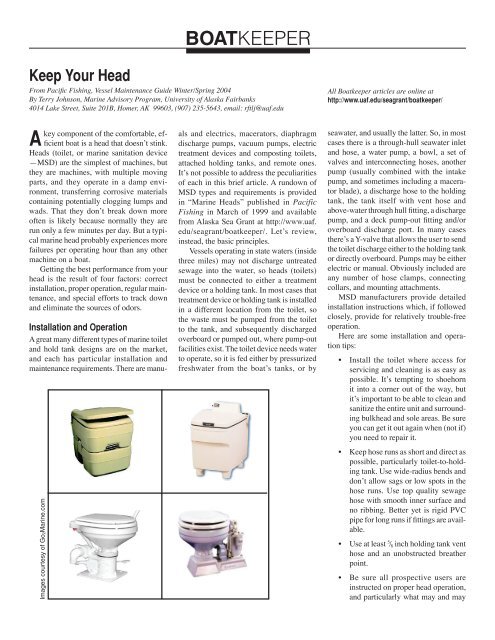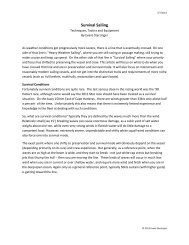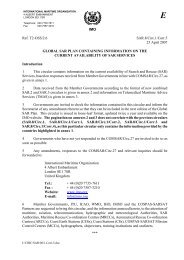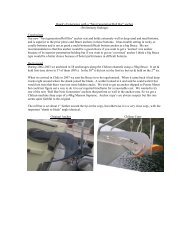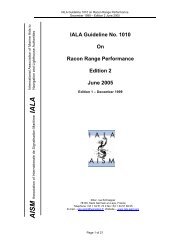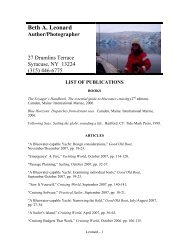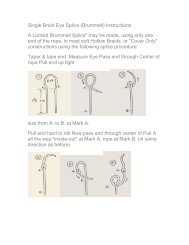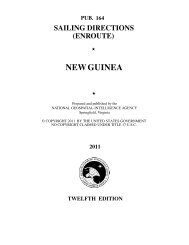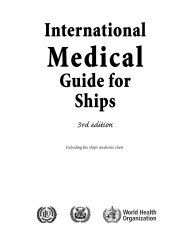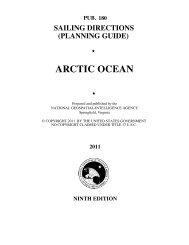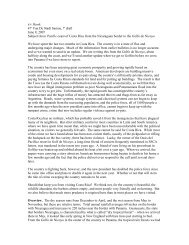Keep your head - Alaska Sea Grant College Program - University of ...
Keep your head - Alaska Sea Grant College Program - University of ...
Keep your head - Alaska Sea Grant College Program - University of ...
Create successful ePaper yourself
Turn your PDF publications into a flip-book with our unique Google optimized e-Paper software.
BOATKEEPER<br />
<strong>Keep</strong> Your Head<br />
From Pacific Fishing, Vessel Maintenance Guide Winter/Spring 2004<br />
By Terry Johnson, Marine Advisory <strong>Program</strong>, <strong>University</strong> <strong>of</strong> <strong>Alaska</strong> Fairbanks<br />
4014 Lake Street, Suite 201B, Homer, AK 99603, (907) 235-5643, email: rftlj@uaf.edu<br />
All Boatkeeper articles are online at<br />
http://www.uaf.edu/seagrant/boatkeeper/<br />
A<br />
key component <strong>of</strong> the comfortable, efficient<br />
boat is a <strong>head</strong> that doesnʼt stink.<br />
Heads (toilet, or marine sanitation device<br />
—MSD) are the simplest <strong>of</strong> machines, but<br />
they are machines, with multiple moving<br />
parts, and they operate in a damp environment,<br />
transferring corrosive materials<br />
containing potentially clogging lumps and<br />
wads. That they donʼt break down more<br />
<strong>of</strong>ten is likely because normally they are<br />
run only a few minutes per day. But a typical<br />
marine <strong>head</strong> probably experiences more<br />
failures per operating hour than any other<br />
machine on a boat.<br />
Getting the best performance from <strong>your</strong><br />
<strong>head</strong> is the result <strong>of</strong> four factors: correct<br />
installation, proper operation, regular maintenance,<br />
and special efforts to track down<br />
and eliminate the sources <strong>of</strong> odors.<br />
Images courtesy <strong>of</strong> Go2Marine.com<br />
Installation and Operation<br />
A great many different types <strong>of</strong> marine toilet<br />
and hold tank designs are on the market,<br />
and each has particular installation and<br />
maintenance requirements. There are manuals<br />
and electrics, macerators, diaphragm<br />
discharge pumps, vacuum pumps, electric<br />
treatment devices and composting toilets,<br />
attached holding tanks, and remote ones.<br />
Itʼs not possible to address the peculiarities<br />
<strong>of</strong> each in this brief article. A rundown <strong>of</strong><br />
MSD types and requirements is provided<br />
in “Marine Heads” published in Pacific<br />
Fishing in March <strong>of</strong> 1999 and available<br />
from <strong>Alaska</strong> <strong>Sea</strong> <strong>Grant</strong> at http://www.uaf.<br />
edu/seagrant/boatkeeper/. Letʼs review,<br />
instead, the basic principles.<br />
Vessels operating in state waters (inside<br />
three miles) may not discharge untreated<br />
sewage into the water, so <strong>head</strong>s (toilets)<br />
must be connected to either a treatment<br />
device or a holding tank. In most cases that<br />
treatment device or holding tank is installed<br />
in a different location from the toilet, so<br />
the waste must be pumped from the toilet<br />
to the tank, and subsequently discharged<br />
overboard or pumped out, where pump-out<br />
facilities exist. The toilet device needs water<br />
to operate, so it is fed either by pressurized<br />
freshwater from the boatʼs tanks, or by<br />
seawater, and usually the latter. So, in most<br />
cases there is a through-hull seawater inlet<br />
and hose, a water pump, a bowl, a set <strong>of</strong><br />
valves and interconnecting hoses, another<br />
pump (usually combined with the intake<br />
pump, and sometimes including a macerator<br />
blade), a discharge hose to the holding<br />
tank, the tank itself with vent hose and<br />
above-water through hull fitting, a discharge<br />
pump, and a deck pump-out fitting and/or<br />
overboard discharge port. In many cases<br />
thereʼs a Y-valve that allows the user to send<br />
the toilet discharge either to the holding tank<br />
or directly overboard. Pumps may be either<br />
electric or manual. Obviously included are<br />
any number <strong>of</strong> hose clamps, connecting<br />
collars, and mounting attachments.<br />
MSD manufacturers provide detailed<br />
installation instructions which, if followed<br />
closely, provide for relatively trouble-free<br />
operation.<br />
Here are some installation and operation<br />
tips:<br />
• Install the toilet where access for<br />
servicing and cleaning is as easy as<br />
possible. Itʼs tempting to shoehorn<br />
it into a corner out <strong>of</strong> the way, but<br />
itʼs important to be able to clean and<br />
sanitize the entire unit and surrounding<br />
bulk<strong>head</strong> and sole areas. Be sure<br />
you can get it out again when (not if)<br />
you need to repair it.<br />
• <strong>Keep</strong> hose runs as short and direct as<br />
possible, particularly toilet-to-holding<br />
tank. Use wide-radius bends and<br />
donʼt allow sags or low spots in the<br />
hose runs. Use top quality sewage<br />
hose with smooth inner surface and<br />
no ribbing. Better yet is rigid PVC<br />
pipe for long runs if fittings are available.<br />
• Use at least 5 / 8 inch holding tank vent<br />
hose and an unobstructed breather<br />
point.<br />
• Be sure all prospective users are<br />
instructed on proper <strong>head</strong> operation,<br />
and particularly what may and may
not be put in the toilet. Many adhere<br />
to the “only what youʼve first eaten”<br />
policy (plus some suitable toilet<br />
paper), and “gentlemen please be<br />
seated” is an effective way <strong>of</strong> minimizing<br />
<strong>head</strong> compartment odors.<br />
• Encourage users to operate the pump<br />
long enough to ensure that waste is<br />
flushed all the way out the hose to the<br />
holding tank. Waste standing in the<br />
hose is a source <strong>of</strong> unpleasant odors.<br />
• Ensure than no one puts bleaches,<br />
caustic cleaners, pine oil, alcohol, or<br />
any petroleum products into the toilet.<br />
They will destroy seals, gaskets,<br />
hose linings, and valves.<br />
• Use only single-ply fast dissolving<br />
toilet paper. The cheap generic brand<br />
household stuff is just as good as the<br />
expensive “marine” TP. If youʼre not<br />
sure about a particular brand, drop<br />
a square <strong>of</strong> it in a cup <strong>of</strong> water and<br />
swirl it a moment. If the paper starts<br />
coming apart itʼs good for a marine<br />
<strong>head</strong>.<br />
Regular Maintenance<br />
Buy a repair kit and keep it on board, along<br />
with the ownerʼs manual. Anticipate potential<br />
problems and prevent them rather than<br />
repairing the <strong>head</strong> after it breaks down.<br />
Inspect the unit regularly, looking for signs<br />
<strong>of</strong> leaks, rust, cracking <strong>of</strong> hoses or porcelain,<br />
any loose attachments or parts, snugness<br />
<strong>of</strong> hose clamps, and signs <strong>of</strong> corrosion on<br />
electrical contacts.<br />
Each type <strong>of</strong> toilet and MSD has its own<br />
needs, but some general principles apply to<br />
most <strong>of</strong> them:<br />
• <strong>Sea</strong>water and urine both cause calcium<br />
“scale” to form on the inside<br />
<strong>of</strong> passageways and hoses. Like<br />
plaque in arteries, it can build to the<br />
point <strong>of</strong> eventually choking <strong>of</strong>f the<br />
flow. A weekly treatment <strong>of</strong> white<br />
vinegar in the bowl will dissolve the<br />
scale. If you find evidence <strong>of</strong> scale<br />
in the intake line, close the valve at<br />
the through-hull and treat that line<br />
with vinegar too. A 10% solution<br />
<strong>of</strong> muriatic acid is a more powerful<br />
scale remover.<br />
• Vinegar can also be used to get the<br />
calcium scale ring <strong>of</strong>f the inside <strong>of</strong><br />
the bowl.<br />
• Most types <strong>of</strong> marine toilets have a<br />
set <strong>of</strong> flapper valves and a “joker” or<br />
duck-bill valve (which blocks odors<br />
from coming back into the toilet from<br />
the discharge line). These should be<br />
changed regularly, like once every<br />
two to three years.<br />
• Some marine writers advocate pouring<br />
a little vegetable oil or mineral oil<br />
down the toilet to keep those valves<br />
supple, and to “lubricate the leathers”<br />
<strong>of</strong> the manual pump plunger if the<br />
unit has one. However, the nationʼs<br />
foremost expert on marine <strong>head</strong>s, a<br />
woman by the name <strong>of</strong> Peggy Hall<br />
who runs a consulting firm specializing<br />
in all matters pertaining to<br />
boat toilets, directly contradicts this<br />
advice.<br />
• If you have a manual <strong>head</strong>, dismantle<br />
the pump occasionally, check the<br />
plunger and its O-rings (or “leathers”)<br />
and grease with a non-petroleum<br />
grease. Lubricate all moving<br />
parts with appropriate spray or<br />
grease.<br />
• Spray electrical contacts regularly to<br />
prevent corrosion. If electric pump<br />
works slowly or irregularly, suspect<br />
faulty electrical connections.<br />
• Check seacocks and Y-valves regularly<br />
to ensure they are free <strong>of</strong> corrosion<br />
and operate easily.<br />
• Winterize <strong>your</strong> system by cleaning<br />
it and then getting all the water out,<br />
by whatever means necessary. Some<br />
people advocate use <strong>of</strong> ethylene<br />
glycol (“RV antifreeze”) but the stuff<br />
is expensive, quite a bit would be required,<br />
and it may also cause damage<br />
to system components. If thereʼs no<br />
water in the system (a small amount<br />
in the holding tank is OK) thereʼs<br />
nothing to freeze.<br />
Preventing Odors<br />
Marine <strong>head</strong>s donʼt have to stink. There are<br />
a few common causes <strong>of</strong> odors and most can<br />
be eliminated with minimal effort.<br />
First be sure the toilet exterior and surrounding<br />
<strong>head</strong> compartment area are kept<br />
clean. A regular scrub-down with detergent<br />
and a mild bleach solution or Lysol helps.<br />
Again, persuading the males on the crew to<br />
sit during all uses makes the job easier.<br />
If the toilet is supplied with seawater,<br />
odor results from minute marine organisms<br />
(plant and animal) that die and decompose<br />
in the system. Thatʼs why some <strong>of</strong> the<br />
more expensive MSDs use freshwater. The<br />
fix for a seawater system is just to flush it<br />
frequently and thoroughly. A strainer on the<br />
intake line will diminish the amount <strong>of</strong> these<br />
sea creatures that get in, but then you have<br />
one more thing that needs cleaning and can<br />
become clogged. You can add little in-line<br />
treatment units that dissolve some kind <strong>of</strong><br />
sweet-smelling blue chemical into the incoming<br />
water, but thatʼs not really necessary<br />
if the system is flushed frequently.<br />
Many <strong>head</strong> compartment odor problems<br />
originate in the hoses or in the holding tank<br />
rather than in the toilet. Here are some tips<br />
for addressing those problems:<br />
• Even top quality hose eventually<br />
becomes permeable to odors. Wrap<br />
a damp towel around the discharge<br />
hose, leave it a few minutes, then<br />
remove and sniff. If it stinks, the hose<br />
is a source <strong>of</strong> odors and needs to be<br />
replaced.<br />
• Check hose clamps and all joints or<br />
connectors for indications <strong>of</strong> fluid or<br />
odor leak. Use a sealing compound<br />
when re-connecting joints.<br />
• Because waste left standing in the<br />
discharge hose is a common source<br />
<strong>of</strong> odor, at least at the end <strong>of</strong> the day<br />
thoroughly flush the line. If holding<br />
tank capacity is an issue, close the<br />
seacock, pump the bowl dry, then run<br />
a few quarts <strong>of</strong> freshwater through<br />
the line.<br />
• Odors are caused by anaerobic (in the<br />
absence <strong>of</strong> oxygen) bacteria. Ensure<br />
adequate ventilation <strong>of</strong> the holding<br />
tank. That means make sure that the<br />
vent hose is large enough and is unobstructed<br />
(an obstructed vent can also<br />
cause holding tank implosion during<br />
pump-out and explosion if waste is<br />
forced in by a powerful pump). Vent<br />
hoses can become plugged if the tank<br />
is overfilled or if the boat lists heavily<br />
to that side. Some users install dual<br />
vent hoses, terminating on opposite<br />
sides <strong>of</strong> the boat, to get air circulation<br />
in the holding tank. Some even install<br />
aeration systems or ozone generators<br />
to staunch holding tank odors.
• Various chemicals are sold as <strong>head</strong><br />
and holding tank treatments. For<br />
the most part they either cover up<br />
the smell or kill the odor-causing<br />
bacteria, neither <strong>of</strong> which is a suitable<br />
solution. A little minty-smelling<br />
deodorant is OK to spruce the <strong>head</strong><br />
up, but use it only after addressing<br />
the real causes <strong>of</strong> the odor.<br />
• Odors may enter the <strong>head</strong> compartment<br />
from the bilge or other sources,<br />
so check for holes or passages that<br />
could allow them in.<br />
A Couple More Tips<br />
<strong>Keep</strong> several pairs <strong>of</strong> latex gloves handy<br />
for use when doing any <strong>head</strong> repairs. Elbow-length<br />
rubber gloves are helpful if you<br />
really have to get into it. In some cases itʼs<br />
a good idea to don raingear to keep from<br />
contaminating clothing.<br />
Lay out <strong>your</strong> tools, the contents <strong>of</strong> the<br />
repair kit, and the expanded diagram <strong>of</strong> the<br />
toilet before starting work, so you donʼt have<br />
to paw through lockers, boxes, and pages<br />
with stinky fingers.<br />
Itʼs <strong>of</strong>ten easier to work on a toilet by<br />
completely removing it to a more convenient<br />
locations, such as a back deck. Be sure to<br />
shut seacocks if the boat is in the water.<br />
<strong>Keep</strong> careful track <strong>of</strong> all the parts; some may<br />
be particular to the unit and not available at<br />
the local hardware or gear store.<br />
When re-attaching toilet units, tighten<br />
mounting bolts evenly but not too tight. Both<br />
porcelain and plastic mounting feet can be<br />
cracked by over-tightening.<br />
✦


